| Original author(s) | Jeff Minter |
|---|---|
| Developer(s) | Llamasoft |
| Initial release | 1988 [1] [2] |
| Written in | Assembly [1] |
| Platform | Atari ST, Amiga |
| Type | Light synthesizer |
| License | Commercial, shareware |
| Website | minotaurproject |
Trip-a-Tron is a light synthesizer written by Jeff Minter and published through his Llamasoft company in 1988. It was originally written for the Atari ST and later ported to the Amiga in 1990 by Andy Fowler. [3] [4]
Trip-A-Tron was released as shareware, but came in a commercial package with a 3-ring-bound manual and 2 game disks. The trial version contained no limitations, but registration was necessary to obtain the manual, which in turn was essential to learn the script language ("KML" - supposedly "Keyboard Macro Language" and only coincidentally the phonetic equivalent of "camel"), which drove the system.
The software has a usable but quirky user interface, filled with in-jokes and references to Llamasoft mascots. For example, the button to exit from the MIDI editor is labelled "naff off", while the button to exit the file display is labelled with a sheep saying "Baa!"; the waveform editor colour cycles the words "Dead cool" above the waveform display, and the event sequencer displays an icon of a camel smoking a cigarette; and the image manipulation tool has a series of icons used to indicate how long the current operation is going to take: "Make the tea", "Have a fag", "Go to bed", "Go to sleep", "Go on holiday", "Go to Peru for six months", and "RIP"; and the scripting language command to set the length of drawn lines is "LLAMA". (The manual states: "I could have called the command LINELENGTH I suppose, but I like llamas so what the heck".)
In spite of this the software is extremely usable and was recommended as one of the best light synthesizers available at the time.[ citation needed ] [5] [6]
The Konix Multisystem was a cancelled video game system under development by Konix, a British manufacturer of computer peripherals.
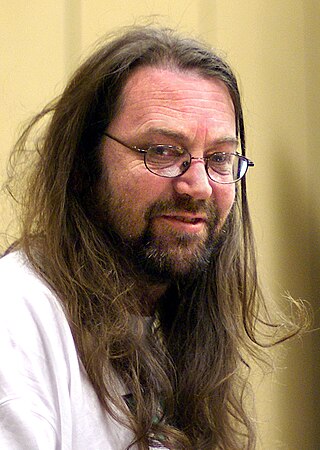
Jeff Minter is an English video game designer and programmer who often goes by the name Yak. He is the founder of software house Llamasoft and has created dozens of games during his career, which began in 1981 with games for the ZX80. Minter's games are shoot 'em ups which contain titular or in-game references demonstrating his fondness of ruminants. Many of his programs also feature something of a psychedelic element, as in some of the earliest "light synthesizer" programs including Trip-a-Tron.

Llamatron is a multidirectional shooter video game programmed by Jeff Minter of Llamasoft and released in 1991 for the Atari ST and Amiga and in 1992 for MS-DOS. Based on Robotron: 2084, players of Llamatron control the eponymous creature in an attempt to stop an alien invasion of Earth and rescue animals—referred to as "Beasties"—for points. Players advance by destroying all of the enemies on each level using a laser that fires automatically in the direction that the Llamatron is moving. Various power-ups exist to aid the player in defeating the wide variety of enemies and obstacles they face along the way.

Revenge of the Mutant Camels is a horizontally scrolling shooter written by Jeff Minter for the Commodore 64 and published by Llamasoft in 1984. Enhanced versions for the Atari ST, Amiga, and IBM PC were released in 1992 as shareware.

Human Engineered Software was an American software developer and publisher from 1980 until 1984. The company sold video games and educational and productivity software, in addition to several hardware products. It focused on the Commodore 64, VIC-20, and Atari 8-bit computers.
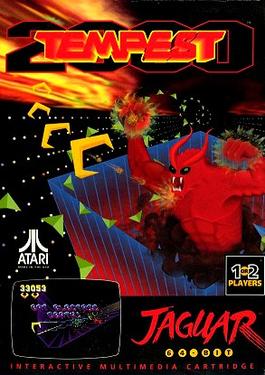
Tempest 2000 is a tube shooter video game originally developed by Llamasoft and published by Atari Corporation for the Atari Jaguar in North America on 13 April 1994. It was released in Europe on 27 June and in Japan on 15 December of the same year, with the Japanese release being published by Mumin Corporation. Part of Atari Corp.'s 2000 series, it is a remake by Jeff Minter of Dave Theurer's 1981 arcade game Tempest, which used Atari's QuadraScan vector color display technology.
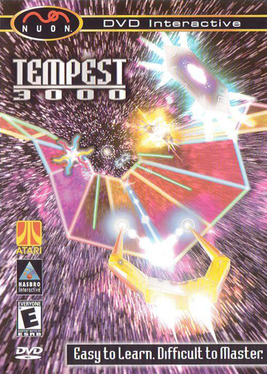
Tempest 3000 is a tube shooter video game developed by Llamasoft for the Nuon. It was published by Hasbro Interactive in North America on December 13, 2000, and Europe on March 2001. It is a follow-up to Tempest 2000, an updated remake of Dave Theurer's arcade game Tempest (1981). The player controls a claw-shaped blaster, shooting at enemies and obstacles, scoring points, and surviving multiple levels. The game modifies and builds upon the gameplay from Tempest 2000, introducing new enemies and mechanics.
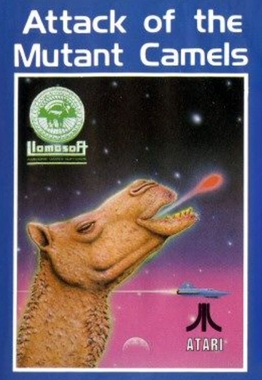
Attack of the Mutant Camels is a surrealist video game written by Jeff Minter and released for the Commodore 64 and Atari 8-bit computers in 1983 by Minter's Llamasoft. The horizontally scrolling shooter is similar to the Atari 2600 game The Empire Strikes Back (1982), with AT-AT walkers replaced by giant camels. Confusingly, a very different game from Jeff Minter's Gridrunner series was also released in the US under the name Attack of the Mutant Camels.
The Virtual Light Machine (VLM) is a light synthesizer developed by Jeff Minter in 1990. It was installed into a number of electronics, including the Atari Jaguar CD and Nuon DVD players.
Neon is a light synthesizer developed by Jeff Minter ('Yak') and Ivan Zorzin ('Giles'). It was based on an enhanced version of the graphics engine originally to be included in Unity, which became an independent project after Unity was cancelled in 2004.

Music visualization or music visualisation, a feature found in electronic music visualizers and media player software, generates animated imagery based on a piece of music. The imagery is usually generated and rendered in real time and in a way synchronized with the music as it is played.
Interceptor Micros, also known as Interceptor Software and later as Interceptor Group, was a British developer/publisher of video games for various 8-bit and 16-bit computer systems popular in Western Europe during the eighties and early nineties.

Hover Bovver is a 1983 maze video game written by Jeff Minter released for the Commodore 64. A port to Atari 8-bit computers by Aaron Liddiment followed in 1984. Like many of Minter's other games, it has an offbeat sense of humour. The background music is based on the folk tune "Country Gardens" by Percy Grainger, arranged by James Lisney.
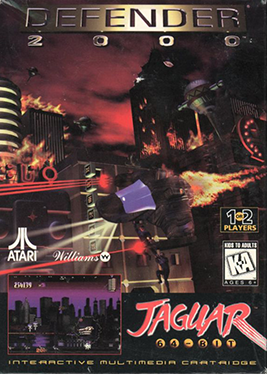
Defender 2000 is a 1996 scrolling shooter video game developed by Llamasoft and published by Atari Corporation for the Atari Jaguar. Part of Atari's 2000 series of arcade game revivals, it is an update of Eugene Jarvis' arcade game Defender (1981). The premise takes place in a future where the Alpha Promixian empire attack mining settlements on distant resource planets. Gameplay is divided into three modes, with the player acting as part of the System Defense Team commanding the Threshold ship to defeat waves of invading aliens while protecting humans.
Non-games are a class of software on the border between video games and toys. The term "non-game game" was coined by late Nintendo president Satoru Iwata, who describes it as "a form of entertainment that really doesn't have a winner, or even a real conclusion". Will Wright had previously used the term "software toy" for the same purpose. The main difference between non-games and traditional video games is the lack of structured goals, objectives, and challenges. This allows the player a greater degree of self-expression through freeform play, since they can set up their own goals to achieve. Some genres that have been considered non-games include language-learning software, digital tabletop games, puzzle games, simulation games, and art games.

Gridrunner is a fixed shooter video game written by Jeff Minter and published by Llamasoft for the VIC-20 in 1982. It was ported to the Atari 8-bit computers, ZX Spectrum, Commodore 64, Commodore PET and Dragon 32. Many remakes and sequels have followed, including versions for the Atari ST, Amiga, Pocket PC, Microsoft Windows, and iOS.
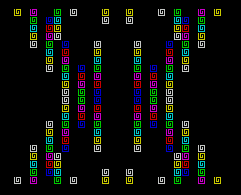
Psychedelia is an early light synthesizer developed by Jeff Minter and published by Llamasoft in 1984. It was converted to the MSX and ZX Spectrum by Simon Freeman.

Preppie! is an action video game for Atari 8-bit computers published by Adventure International in 1982. It was programmed by Russ Wetmore of Star Systems Software, whose name is prominently displayed on the box cover. Leaning on the preppy trend of the early 1980s, the game follows prep schooler Wadsworth Overcash as he navigates the hazards of a country club to retrieve golf balls. Preppie! borrows heavily from Konami's Frogger, with lanes of traffic in the bottom half of the screen and a river crossing the top portion. Alligators are an element from both Frogger and preppy fashion; an open-mouthed gator is the icon of shirt brand Izod. Reviewers recognized the game as derivative, but called the music and visuals some of the best for Atari 8-bit computers.

Llamasoft: The Jeff Minter Story is an interactive documentary and compilation video game developed by Digital Eclipse. The release chronicles the software of British developer Jeff Minter and over 40 of his programs developed between 1981 and 1994. It is the second release in Digital Eclipse's Gold Master Series that began with The Making of Karateka (2023), which chronicled the history of the game Karateka (1984).
{{cite web}}: CS1 maint: bot: original URL status unknown (link)